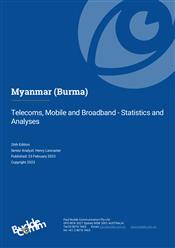Myanmar (Burma) Telecoms Market Report
Telecoms, Mobile and Broadband - Statistics and Analyses

Myanmar’s foreign telcos exit under market pressures
The outlook for Myanmar’s telecom sector – along with the prospects for the rest of the country – appear increasingly grim. A military coup in February 2021 reversed much of the progress made since the telecom market was liberalised in 2014. With one of the two privately-owned mobile operators being forced into a fire sale and a rapid exit (leaving more than 16 million subscribers’ communications exposed to scrutiny from the junta), there appears little chance of Myanmar returning to anywhere near the levels of growth and relative prosperity experienced during the decade of civilian rule.
Following the awarding of two new mobile licenses (to Qatar’s Ooredoo and Norway’s Telenor Group) in 2014, the number of Myanmar’s mobile subscribers more than doubled over the following five years, exceeding a penetration rate above 120%, though since then growth has been more moderate.
Mobile broadband penetration followed a similar trajectory, with spectacular growth from a nascent market in 2013, to reaching a 90% penetration rate by 2017. The onset of the pandemic dampened the growth rate in 2020 and 2021, but it was the return to military law at the start of 2021 which really turned the situation on its head. The coup resulted in a complete shutdown of the internet for April of that year, while the junta’s soldiers also damaged infrastructure such as data centres. Additional tax burdens imposed as part of the Union Tax Law 2021, and charges for new SIM card registrations, have resulted in more expensive services for end-users, and stressed the finances of the key telcos Ooredoo Myanmar and Telenor Myanmar.
Before the coup took place, officials from the Ministry of Transport and Communications (MoTC) issued orders for the country’s telcos to install surveillance software (spyware) in their networks to allow the army to eavesdrop on the communications (both voice and data) of private citizens. While the government-backed operators MPT and Mytel were most likely to have complied, Ooredoo and Telenor resisted the demands. That led to the military banning the executives of the private operators from leaving the country, as well as threatening to rescind their mobile licenses. Rather than acceding to such demands, Telenor chose to withdraw from the market completely, largely writing off its business in a fire sale to Lebanon’s M1 Group.
Ooredoo Group delayed following suit until September 2022, when it announced an agreement to sell its local unit to Nine Communications (based in Singapore) for $576 million.
This report includes telcos' financial and operating data updates to December 2022, as well as Telecom Maturity Index charts and analyses, the ITU’s data updates to 2021, and recent market developments.
Key developments:
- 8,100km Myanmar/Malaysia-India-Singapore Transit (MIST) cable system expected to be completed by end-2023.
- Telenor exits the Myanmar mobile market in a fire sale to Lebanon’s M1 following the imposition of military rule.
- Ooredoo Group agrees sale of its local Myanmar unit.
- Campana Group’s 2,227km Singapore-Myanmar (SIGMAR) system is lit, with a landing station at Thanlyin.
- M1 agrees to sell a majority share of its Telenor acquisition to local interests, as dictated by the Ministry of Transport and Communications.
- Malaysia carrier Axiata Group puts its planned listing of towerco Edotco on hold due to the political unrest.
- E-commerce transactions grew significantly during the pandemic.
Companies mentioned in this report
Myanmar Post and Telecommunications (MPT), ATOM (Telenor Myanmar), Ooredoo Myanmar, Mytel.
Related Reports
- Asia - Mobile Infrastructure and Mobile Broadband
- Asia - Fixed Broadband Market - Statistics and Analyses
- Asia - Mobile Network Operators and MVNOs
- Uzbekistan - Telecoms, Mobile and Broadband - Statistics and Analyses
- Taiwan - Telecoms, Mobile and Broadband - Statistics and Analyses
- China - Telecoms, Mobile and Broadband - Statistics and Analyses
- South Korea - Telecoms, Mobile and Broadband - Statistics and Analyses
- Azerbaijan - Telecoms, Mobile and Broadband - Statistics and Analyses
Share this Report
TMT Intelligence
A platform to scale your intelligence tasks
Monitor critical insights with our AI-powered Market Intelligence Platform gathering and analyzing intelligence in real time. With AI trained to spot emerging trends and detect new strategic opportunities, our clients use TMT Intelligence to accelerate their growth.
If you want to know more about it, please see:
Research Methodology
BuddeComm's strategic business reports contain a combination of both primary and secondary research statistics, analyses written by our senior analysts supported by a network of experts, industry contacts and researchers from around the world as well as our own scenario forecasts.
For more details, please see:
More than 4,000 customers from 140 countries utilise BuddeComm Research
Are you interested in BuddeComm's Custom Research Service?
Hot Topics
News & Views
Have the latest telecommunications industry news delivered to your inbox by subscribing to BuddeComm's weekly newsletter.